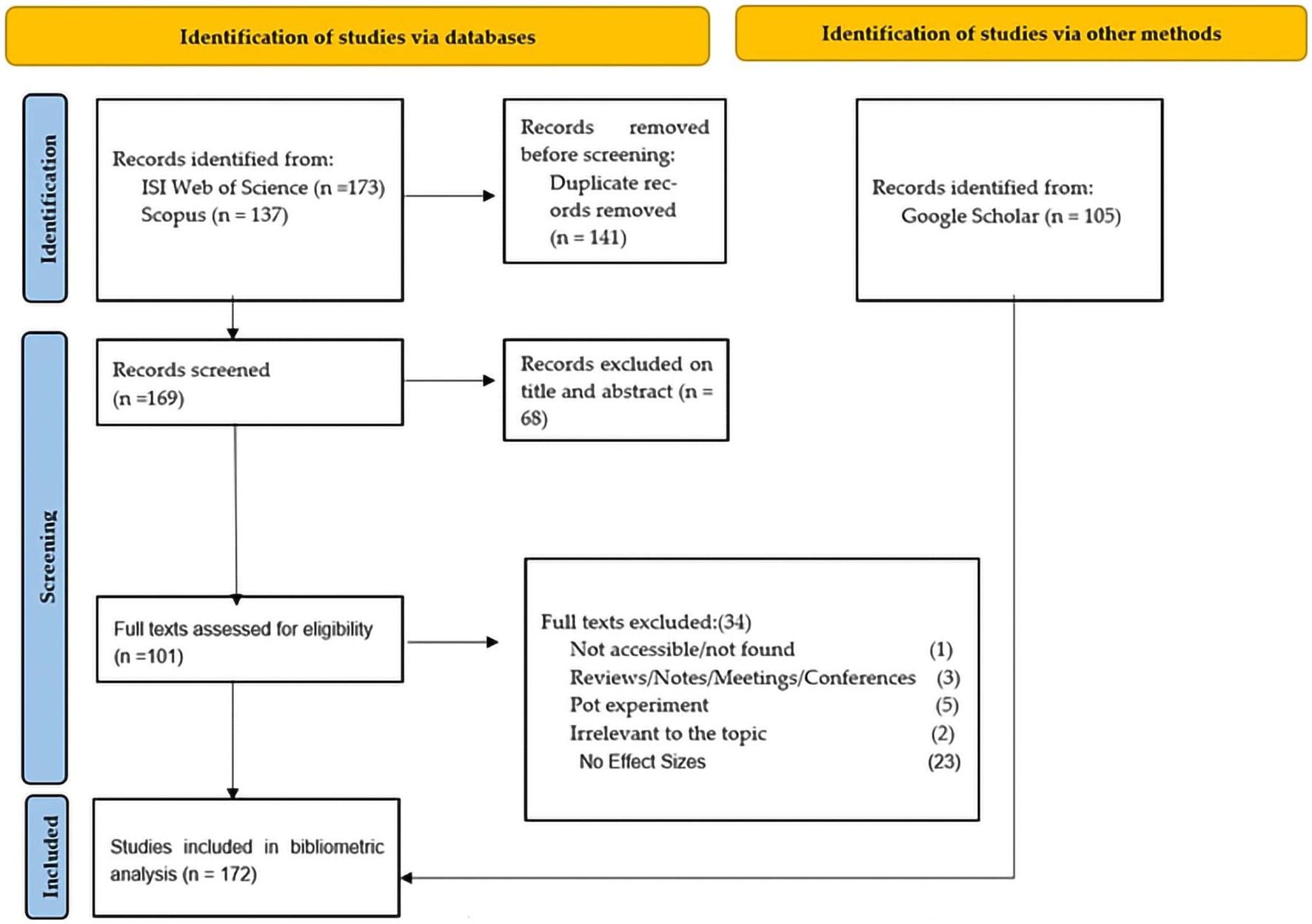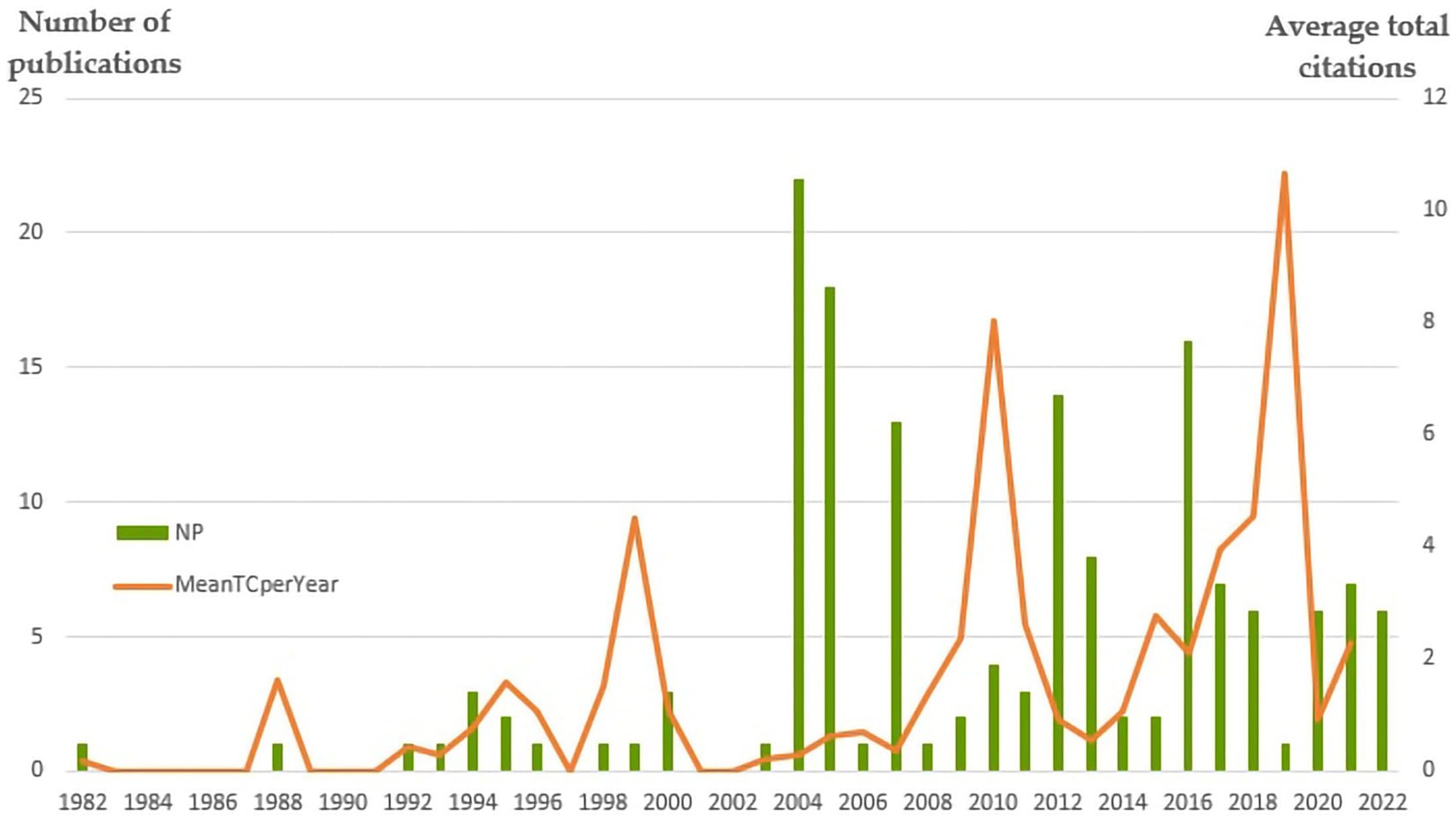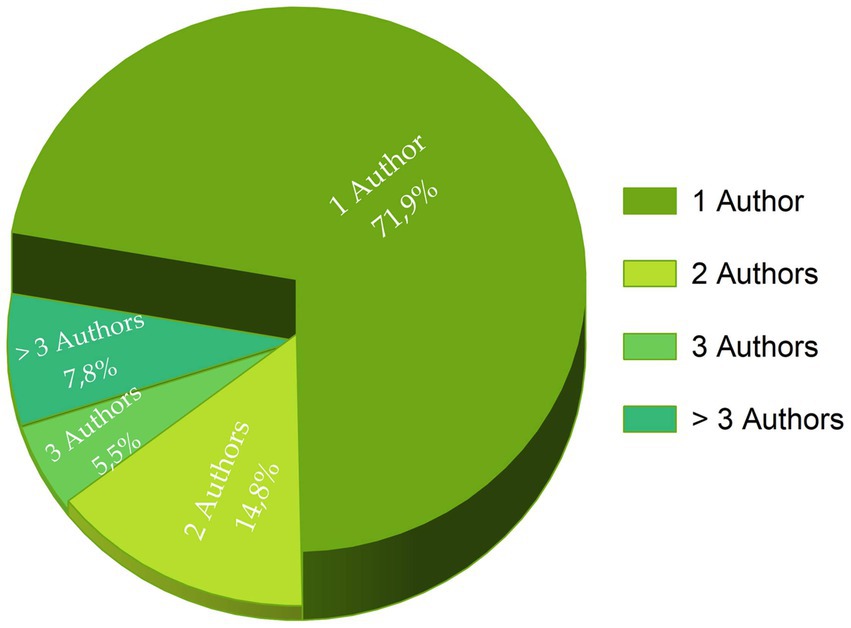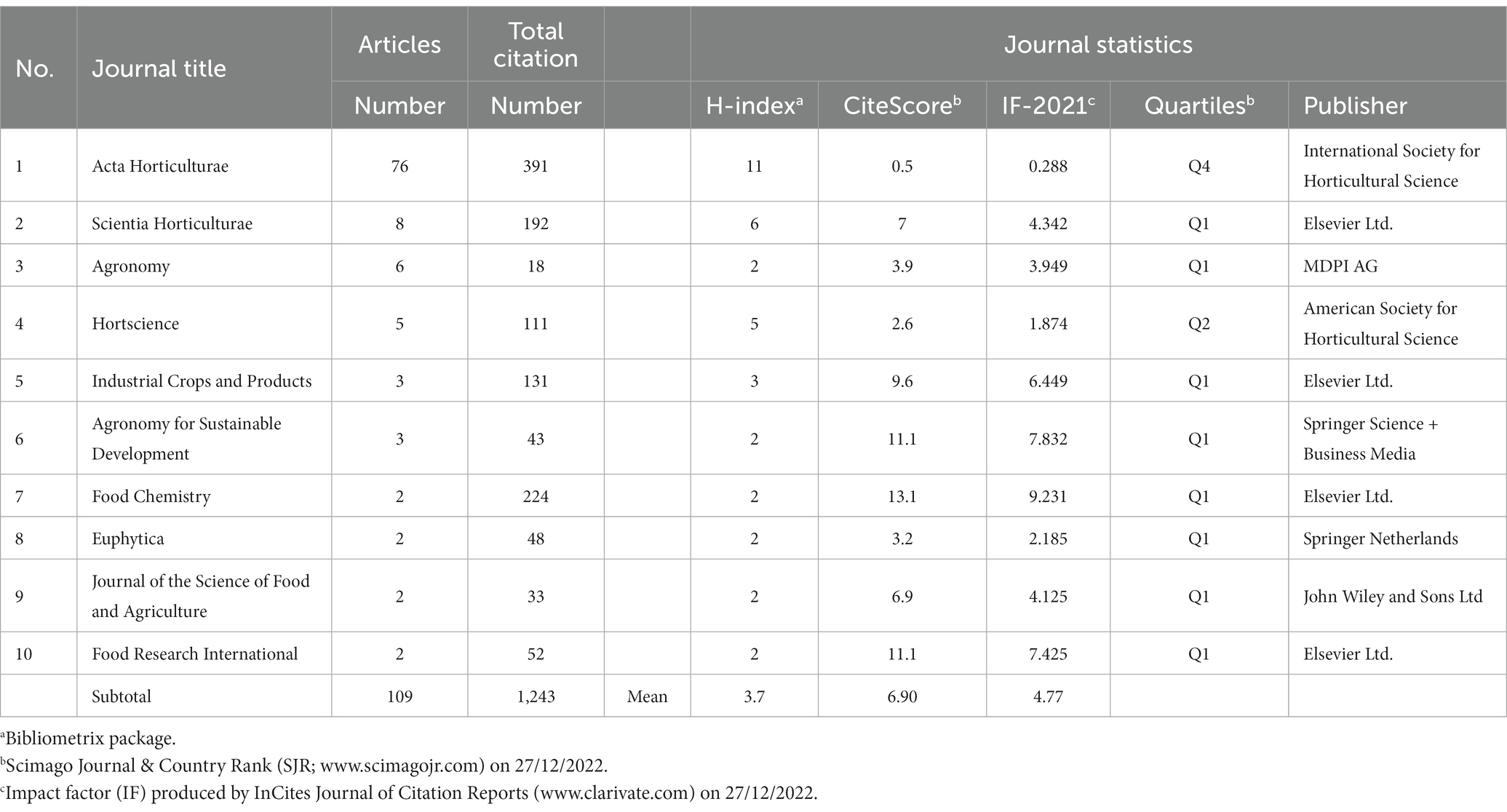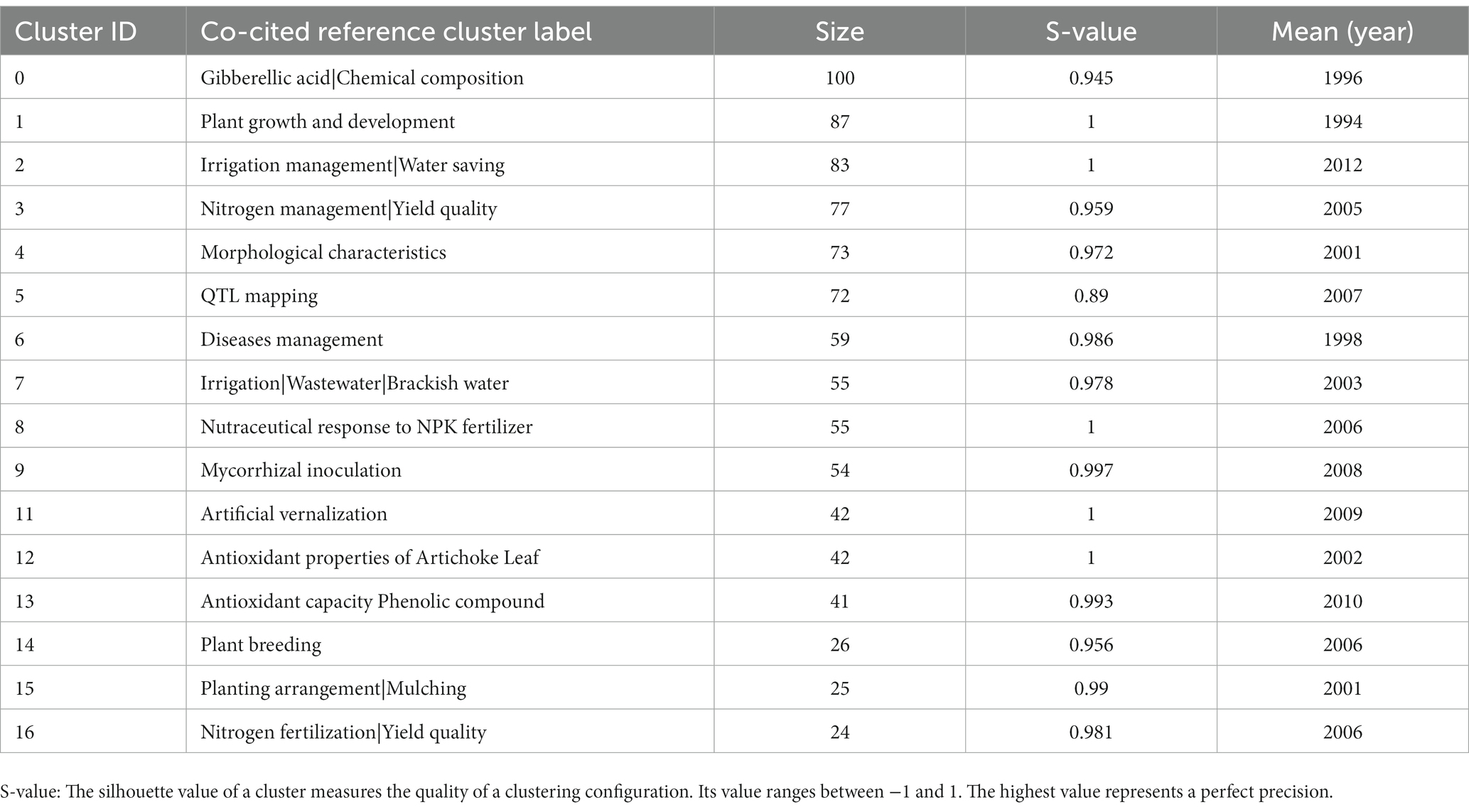- 1Department of Agricultural and Environmental Science, University of Bari “A. Moro”, Bari, Italy
- 2Institute for Mediterranean Agricultural and Forestry Systems, National Research Council of Italy, Naples, Italy
- 3Department of Agronomy, Food, Natural Resources, ARCA, Acerra (NA), Italy
- 4Department of Agronomy, Food, Natural Resources, Planetek Italia Srl, Bari, Italy
Globe artichoke is a food plant that is gaining increasing interest due to its commercial, nutritional and therapeutic value; research and development in the field of agriculture for this crop encompasses several key areas to enhance cultivation, productivity, and overall sustainability. In this study a bibliometric analysis of literature has been carried out in order to identify research areas and research gaps in cropping management of globe artichoke under field conditions, and to identify new research opportunities. The analysis revealed that published articles on the agronomic practices of globe artichoke under field conditions, is concentrated in Europe (70.56%), followed by North America (10%) and South America (7.22%). On the vastly arid Australian continent, there is a dearth of such studies. Italy, Spain and USA, were the most productive countries in the globe artichoke research field. The analysed papers have also shown that agronomic practices such as irrigation (wastewater and brackish water), fertilization, diseases management and plant breeding are the most studied cropping practices that affect artichoke yield and head quality. Finally, this study highlights the importance of integrating innovative methods like meta-analysis to gain a more holistic comprehension of how agricultural practices impact globe artichoke and to lays the groundwork for future research endeavours.
1. Introduction
Globe artichoke (Cynara cardunculus L. var. scolymus (L.) Fiori), is a perennial plant that belongs to the Asteraceae family. The globe artichoke is grown in many countries around the world, with the largest producers being Italy, Egypt, Spain, Algeria, and Peru, with an estimated annual production of around 376,280, 315,408, 214,560, 120,932 and 99,518 tons, respectively (Food and Agricultural Organization, 2021). The globe artichoke is a crop with an importance commercial, nutritional and therapeutic value. According to the Food and Agriculture Organization (FAO), global production of artichokes has steadily increased over the past decade, from approximately 1.4 million tons in 2010 to 1.9 million tons in 2019 (Food and Agricultural Organization, 2021). This increase in production is accompanied by a growing market for artichokes, which was valued at around USD 3.5 billion in 2020 and is projected to reach USD 5.2 billion by 2026, growing at a compound annual growth rate (CAGR) of 6.3% during the forecast period (2021–2026; Research, 2016). It requires a Mediterranean-type climate with cool, wet winters and dry, hot summers (Sonnante et al., 2007). Globe artichoke can be grown on a wide range of soils, but they produce best on deep, well-drained, fertile with a slightly acidic to neutral soils (Bianco and Calabrese, 2009). Globe artichoke cultivation goes beyond its culinary use and its role in landscaping, medicine, energy production and agriculture make it a valuable and versatile plant species. The globe artichoke is an excellent source of dietary fibre as well as many vitamins, including vitamins K and C (Ben Salem et al., 2017). It also contains antioxidants (Quercetin and Rutin) and other plant compounds (Cynarin, Inulin, Flavonoids and minerals) that may have health benefits (Lattanzio et al., 2009; Rezazadeh et al., 2018; Cavini et al., 2020).
In addition to it nutritional properties, the globe artichoke is used in traditional medicine as choleretic, diuretic, laxative, appetite stimulant, anti-gout and purifying (Fleming, 2000; Rondanelli et al., 2013). Since ancient times, people have turned to artichokes as a remedy for a wide range of ailments, including liver and gallbladder disorders (Mehmetçik et al., 2008), high cholesterol (Alzubaidi and Al Diwan, 2013), and digestive issues (Roudsari et al., 2019). Consumption of artichokes has been demonstrated in certain studies to be associated with reduced levels of cholesterol as well as improved liver function (Bundy et al., 2008).
The focus of research and development in the field of agriculture for this crop is encompasses several key areas to enhance cultivation, productivity, and overall stainability. The cultivation of globe artichokes is a dynamic process that has seen a number of innovative developments in the current period. First, there is a focus on varietal improvement through Globe artichoke breeding programs, with the goal of developing artichoke varieties that exhibit improved traits such as higher yields, resistance to diseases, and enhanced flavor (Bekheet and Sota, 2019; López-Anido and Martin, 2021; Spanò et al., 2023). Additionally, optimizing cultivation practices, including planting density, irrigation methods, and pest management, plays a pivotal role in maximizing artichoke yields while conserving resources (Leskovar et al., 2013; Anwar et al., 2017; Fracchiolla et al., 2022). Fertilization practices are under scrutiny to ensure the efficient utilization of nutrients and promote healthy plant growth (Leskovar and Othman, 2016; Petropoulos et al., 2022). The application of biostimulants, biofertilizers, and bioregulators is explored to stimulate plant growth and nutrient uptake (Tartoura et al., 2021; Pandino et al., 2022). This holistic approach underscores the commitment to advancing artichoke cultivation, making it more sustainable and productive while addressing emerging challenges in modern agriculture. Research possibilities and limitations in field globe artichoke cropping management can be better pinpointed with the help of a bibliometric analysis of the relevant literature on globe artichoke.
Bibliometric analysis is a method of studying published literature through the use of numerical data and statistical techniques. This includes evaluating information such as authorship, publication frequency, and citation counts in a specific field or subject area. The objective of bibliometric analysis is to uncover patterns and trends within literature, including the expansion of a field over time, the most productive authors and institutions, and the articles that receive the most citations (Todeschini and Baccini, 2016; Norris, 2019).
By using bibliometric approach, stakeholders and researchers can gain a deeper comprehension of the current status of studies on globe artichoke, identify key researchers, institutions and research trends. Additionally, it can be helpful in identifying knowledge gaps, potential new lines of research, as well as the possible impact of certain studies in the field.
The remainder of this paper is structured as follows. The following, main section presents the methodology employed to describe the search strategy used to gather relevant literature, the criteria for inclusion and exclusion of studies, and the data extraction process. Results section then presents the main findings of the bibliometric analysis, including the publication trends, authorship patterns, citation analysis, and co-citation analysis. Discussion section provides an interpretation of the results and discusses the implications for the research topic, including gaps in the literature and areas for future research. The manuscript closes with a summarizes the main findings of the bibliometric analysis and highlights the key takeaways.
2. Materials and methods
A bibliometric analysis involves a systematic and quantitative analysis of scientific publications, based on citation and co-citation analysis, to identify patterns and trends in research activity on a particular topic (Rons and De Bruyn, 2013). The methodology includes four key components: a comprehensive search strategy, inclusion and exclusion criteria, data ex-traction process and appropriate data analysis methods.
2.1. Search strategy
In this section, the search strategy involves conducting a thorough search of relevant databases and sources, using appropriate search terms and Boolean operators. The evaluation reported here was conducted in September 2022 using a bibliometric analysis of all articles written in the English language that were included in the grey literature (Google Scholar) database and indexed in ISI Web of Science and Scopus. Using the search query below:
({field} AND (({cropping system*} OR ((organic OR conventional OR sustainable) AND agriculture)) OR ((Perennial OR Annual) AND Cultivation) OR (rhizob* OR inocul*) OR (fungi OR mycorriz* OR {PGPR} OR {plant growth promot*} OR biostimulant* OR fertil* OR fulvi* OR humi*) OR (till* OR {conservation agriculture}) OR (sowing AND (date* OR densit*)) OR intercrop* OR (breed* OR ecotyp* OR cultivar* OR landrace* OR genotype* OR accession* OR ecotype*) OR (irrigation OR {deficit irrigation} OR drought OR ((water OR salt) AND stress) OR salin* OR (water AND (quality OR management))) OR (nitrogen OR potassium OR phosphorus) OR (disease OR fung* OR biotic* OR bacter*) OR (pest* OR insect* OR acari*) OR (weed* OR herbicide) OR rotation) AND (((globe OR french OR green) AND artichoke) OR {Cynara cardunculus L. var. scolymus} NOT {Jerusalem Artichoke}) AND (quality OR yield)).
2.2. Inclusion and exclusion criteria
In this study, two criteria were used to select the relevant paper: (1) Studies that were conducted solely in the field, and (2) Research that focused on crop productivity. The search query was formulated using the four PICOL components, which include population, intervention, comparator, outcome, and location (Table 1).
Figure 1 depicts the process of selecting articles for inclusion and exclusion. Endnote version 20.2.1 (Clarivate 2013) was used to automatically eliminate duplicate articles.
2.3. Data extraction process
Data extraction process involves extracting relevant information from the selected publications, such as author names, publication year, citation data, and keywords.
2.4. Data analysis
Data analysis methods such as co-citation analysis, or keyword/terms co-occurrence analysis are applied to the extracted data to identify patterns and trends in research activity. We conducted the quantitative analysis using the software of comprehensive science mapping analysis, bibliometrix package in R (Aria and Cuccurullo, 2017). To generate keywords and term maps, we utilized VOSviewer (van Eck and Waltman, 2009), a software developed by scientometricians for concept network mapping. Additionally, Citespace (Chen, 2006) was used to generate a co-cited reference network.
3. Results
3.1. Basic information of the relevant references
3.1.1. Global scientific production analysis
A total of 172 publications on agronomic practices for increasing globe artichoke yield met all eligibility, inclusion and exclusion criteria that were taken into account when choosing documents for the bibliometric analysis. The Figure 2 shows annual evolution of scientific production and average citations per year since 1982 until 2022. The research papers were disseminated throughout 60 academic journals. The scientific production in this research area experienced a very sluggish annual growth rate of only 4.58%. The scientific production peaks occurred in 2004 and 2005, with 22 and 18 papers, respectively, while there was a sharp decline in publications after 2016 (Figure 2). The importance of this field of study in the past decade is evident in the large number of citations (2,261) and the average number of citations per document (13.15). The rate of growth rate in mean total citations per year since 1982 until 2022 has been cubic polynomial adjustment (data not shown).
There are a total of 385 authors across the 172 articles, representing 2.24 authors per document, with 7 scholars contributing to single-authored documents and 4.26 co-authors per documents. According the Figure 3, 71.9% of scholars published one article during a 42-year period in this research area followed by 14.5% of scholars published two articles in the same period, otherwise the authors have published more than 5 articles are 4.5%. Among scholars who have published in this academic research field over the past 42 years, 71.9% have published no more than one article, 14.5% have published two, and 4.5% have authored five or more publications.
3.1.2. Most productive countries and affiliations
Our analysis of bibliometric data shows that the majority of published articles about agronomic practices for field globe artichoke are found in Europe (127 publications, 70.56%), followed by North America (18 publications, 10%) and South America (13 publications, 7.22%; Figure 4). These three continents together represent 87% of papers published in the globe artichoke research field. On the vastly arid Australian continent, there is a dearth of such studies. The most fruitful nations in the globe artichoke research field were Italy, Spain, and the United States, with 74, 28 and 16 articles, respectively, and they were the most cited countries with 1,487, 266 and 180 cited publications, respectively.
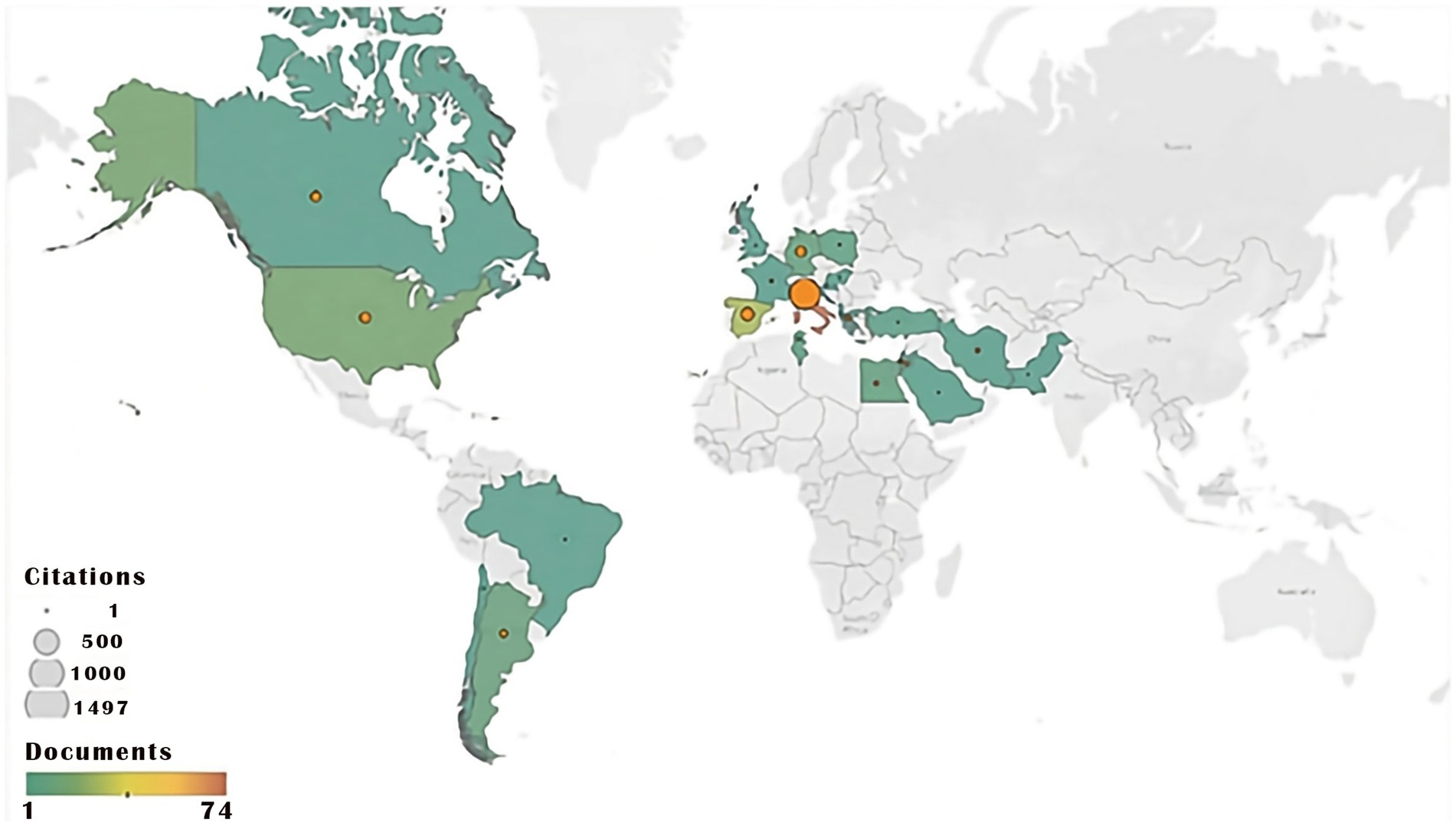
Figure 4. World map displaying the distribution of publications and total citations by country. Citations: Total citations on 27/12/2022.
The international cooperation map is depicted in Figure 5 (at least one articles). Despite the abundance of literature available on the topic of cropping practices of field globe artichoke on the European continent, collaboration among international researchers in this field remains limited. Figure 5 indicates that only 15 countries are involved in international collaboration for globe artichoke research. These countries are grouped into four clusters, which are determined by their areas of cooperation. The closer two countries are on the map, the more collaborations they have between them. However, one of the most significant examples of international collaboration is Italy’s partnerships with countries including Spain, Tunisia, Poland, France, Canada, the United States, and Germany.

Figure 5. Country collaboration network visualization map. Color: represents a cluster of country collab-oration in the globe artichoke research field; Nodes: represent countries (node size based on number of publications); Links: represent collaboration between two countries. Source: VOSviewer (clusters resolution 0.5; minimum cluster size 1 and no merge small clusters).
In terms of the number of publications, research on cropping practices for field globe arti-chokes was produced by 275 different affiliations. According to a bibliometric analysis, half of the top 9 most productive affiliations in this area are from Italy (Table 2). National Research Council (CNR), University of Catania and University of Bari Aldo Moro were the most Italian productive affiliations with 39, 28 and 14 articles, respectively, followed by two Spanish institutions with 20 publications in total (Table 2).
3.1.3. Analysis of sources in globe artichoke publications
The collection of 172 articles were referenced in 60 different sources. Table 3 shows the number and the total citation of publications in the top 10 journals. These 10 journals represent 63 and 58% of the number and the total citation of publications, respectively. In term of the number of publications and the total citations documents, the journal ACTA Horticulturae was the most relevant sources in the globe artichoke research area, with 76 (44% of total number of publications) and 391 (17.3% of total citations) articles and total citations, respectively. Despite the high rate of articles published and cited in this journal, it remains the least valuable compared to other sources, being ranked in the fourth quartile (Q4) of Scimago Journal & Country Rank (SJR). Eight of the other journals, are classified in Q1 with Impact Factor (IF) ranging from 2.185 (Euphytica) to 9.231 (Food Chemistry) and only one in Q2 (Hortscience).
3.1.4. Most productive authors
The Table 4 displays the four most productive authors in the field of cropping practices of field globe artichokes, as determined by the number of publications and citations related to field research. The four authors in question have written 63 articles and been cited 1757 times, which represents 36.63 and 77.71% of all publications and citations, respectively. The analysis of bibliometric data indicates that Mauromicale G. from Catania university in Italy is the leading researcher in the field of globe artichoke, having published 28 articles and receiving a total of 781 citations. The first three authors (Mauromicale G., Lombardo S. and Pandino G.) are researchers in the Catania university (Italy). Followed by Ierna A. from CNR (Italy) with 11 publications and 250 citations.
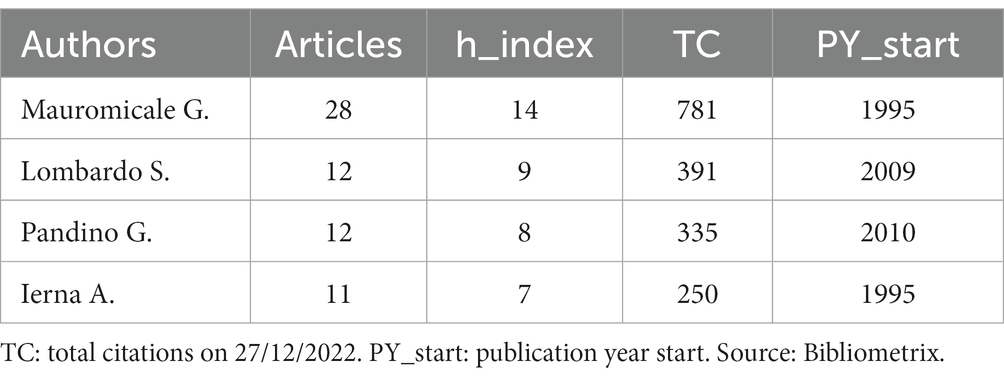
Table 4. Top 4 most relevant authors influential authors in terms of both publications and citations.
3.1.5. Document citation analysis
The top 10 cited publications in the agronomic practices to increase the yield of globe artichoke literature is shown in Figure 6. The top 10 cited publications represent 36% of the total citations (2,261 citations); in tenth position there is manuscript titled “Effects of gibberellic acid and sowing date on harvest time and yields of seed-grown globe artichoke (Cynara scolymus L)” with 48 citations. The article with the most citations was titled “Influence of genotype, harvest time, and plant part on the polyphenolic composition of globe artichoke [Cynara cardunculus L. var. scolymus (L.) Fiori]” and received 158 citations. Followed by the article entitled:” Mycorrhizal colonization impacts on phenolic content and antioxidant properties of artichoke leaves and flower heads 2 years after field transplant” and received 132 citations. Realizing that these two articles were published in 2010.

Figure 6. The top 10 cited articles in the artichoke literature. Legend: authors of top 10 cited articles, publication year, journal and DOI; Radar scale of number of citations. Source: bibliometrix package.
3.2. Conceptual structure
3.2.1. Terms co-occurrence network analysis
Figure 7A shows the terms co-occurrence network analysis of 90 most relevant terms which appeared at least 7 times in title and abstract fields of 172 articles, which includes 90 nodes, 1,118 links and 2,554 total link strength. Each node in the network represents a term, and the size of the node reflects the number of times the term appeared. The connections between terms are determined by the frequency of their occurrence in 172 publications. The higher the frequency of two terms appearing together, the closer they will be positioned on the map. There are two term clusters that share common topics.
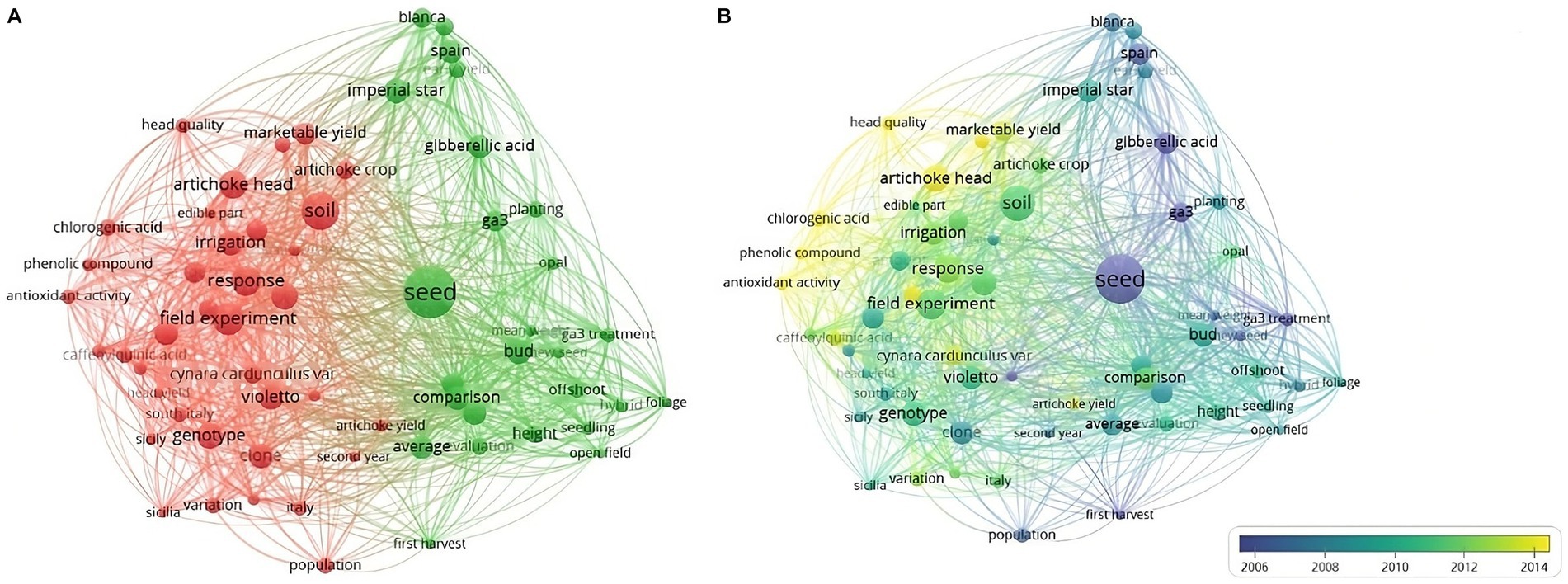
Figure 7. (A) Co-occurrence network and (B) Overlay visualization of 90 most relevant terms which appeared at least 7 times in title and abstract fields of 172 articles. Source: VOSviewer.
The co-occurrence network data illustrates that the green term cluster is related to the impact of foliage treatment by gibberellic acid (GA3) on early yield and first harvest of two cultivars “imperial star” and” blanca” in Spain (especially Tudela). The terms with the highest frequency in this cluster are “seed” (frequency = 42) and “bud” (frequency = 18), “imperial star” (frequency = 18), “Spain” (frequency = 17), “GA3” (frequency = 15), and “blanca” (frequency = 14). Otherwise, the red term cluster is related to impact of cropping practices (fertilization (nitrogen) and irrigation), bioregulator (GA3) and plant breeding (genotype, clone, population) on dry matter, biomass, yield and head quality (flavonoid, phenolic compound, antioxidant activities, chlorogenic acid and caffeoylquinic acid) of globe artichoke in south Italy (especially in Sicily). The terms in this cluster with the highest occurrences are “soil” (frequency = 29), “field experiment” (frequency = 24), “artichoke head” (frequency = 21), “genotype” (frequency = 19), “clone” (frequency = 18), “irrigation” (frequency = 18), “Violetto” (frequency = 18), “gibberellic acid” (frequency = 17), nitrogen (frequency = 17), marketable yield (frequency = 16) and southern Italy (frequency = 15). From the time frame 1982–2022 here in Figure 7B, we report the focus on the evolution of the terms in the co-occurrence network between 2006 to 2014. Our analysis revealed that terms related to the impact of agronomic management on artichoke head quality (phenolic compound, antioxidant activity and chlorogenic acid) appeared later (in 2013, Yellow cluster), while terms related to the impact of bioregulator (GA3) on globe artichoke, first appeared in the early periods (before 2006, Purple cluster).
3.2.2. Keywords co-occurrence network analysis
Figure 8A shows the terms co-occurrence network analysis of 100 most relevant keywords which appeared at least 3 times in 172 articles which includes 100 nodes 997 links and 1,605 total link strength. Each node in the network represents a keyword and the size of the node reflects the number of times the keyword appeared. The network is divided into three clusters of keywords that share similar themes: the red cluster includes keywords related to the impact of plant breeding (genotype germplasm genetic variability and cultivar) irrigation (brackish water and salinity) fertilization (arbuscular mycorrhiza phosphorus and nitrogen) disease management (Brassica oleracea var. botrytis L. and Verticillium dahliae Kleb.) cropping systems (sustainability cover crops and alternative agriculture) and soil moisture conservation (mulch) on artichoke biomass and yield in Mediterranean environment (Italy). The green cluster comprises keywords related to the impact of irrigation methods such as water stress and drip irrigation and fertilization using nitrogen on the quality of globe artichoke (flavonoid phenolic compound antioxidant activities inulin minerals and caffeoylquinic acid). The blue cluster includes the effect of gibberellic acid and fertilization on physiologic parameters (photosynthesis and stomatal conductance) yield and yield quality (chlorogenic acid) of globe artichoke. The evolution of the authors’ keywords in the co-occurrence network is illustrated in Figure 8B. This network map is based on the average number of occurrences of each keyword in our publications. Our analysis revealed that keywords related to the impact of GA3 on globe artichoke yield appeared earlier (before 2006 purple cluster) while keywords related to the impact of cropping practices on globe artichoke yield quality appeared later (in 2013 yellow cluster).
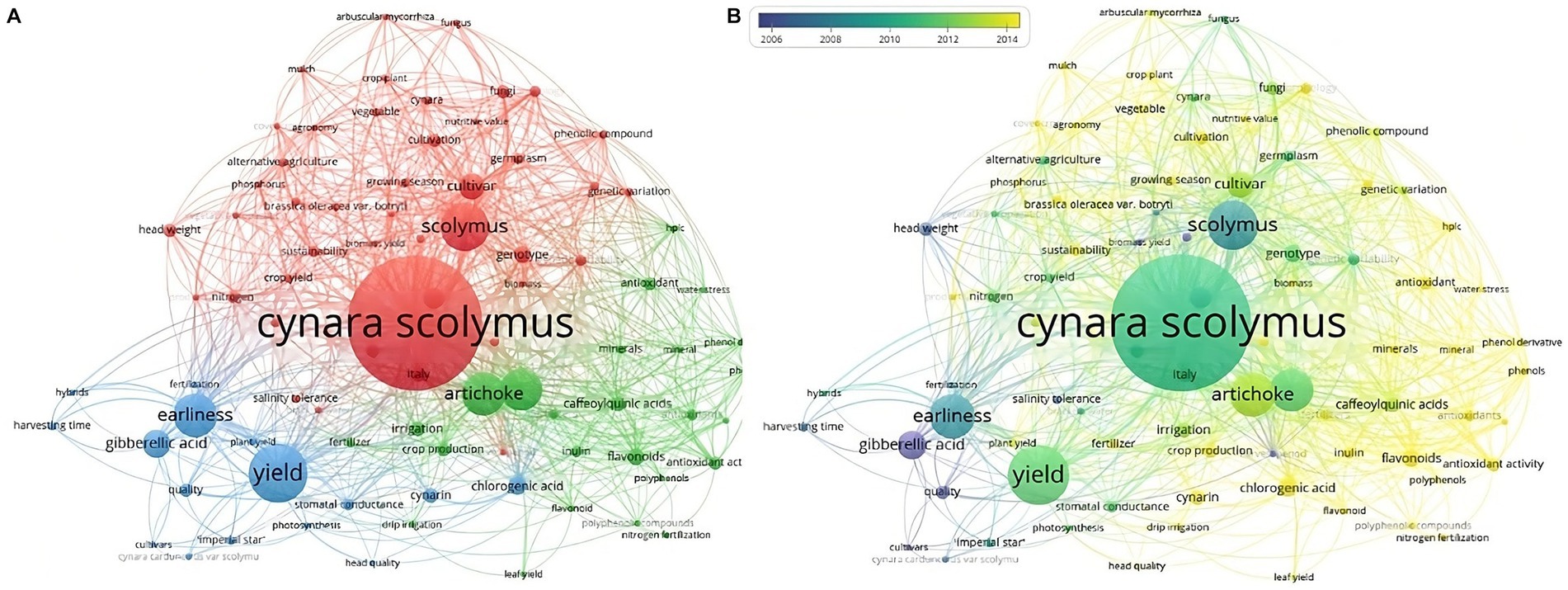
Figure 8. (A) Co-occurrence network and (B) Overlay visualization of 100 most relevant keywords which appeared at least 3 times in 172 articles. Source: VOSviewer.
3.3. Intellectual structure
To identify the most highly-cited publications that are considered essential references in the field of globe artichoke research, a co-cited reference network analysis was conducted (Figure 9). Citespace generated a co-cited reference network based on the average time of appearance of references in the 172 articles. References with high centrality scores are labelled and citation bursts are depicted as red rings. Citations made in earlier years are shown in ripe plum, twilight and muted blue, mid-range years in blue chill, seaweed green and soft green, and recent years in yellowish green and sun yellow. We noted that 16 distinct co-citation clusters or major areas of research were identified within the co-cited reference network. Cluster #0, titled “Gibberellic acid and chemical composition” was the largest co-cited reference, containing 100 references. Followed by Cluster #1 with 87 references and titled “Plant growth and development.” The third co-cited reference cluster labelled “Irrigation management and Water saving” with 83 references. The Table 5 shows the rest of the co-cited reference cluster. The top ranked references by citation counts are Lombardo et al. (2010) in Cluster #0, with citation counts of 6. The second one is Lattanzio et al. (2009) in Cluster #0, with citation counts of 4.
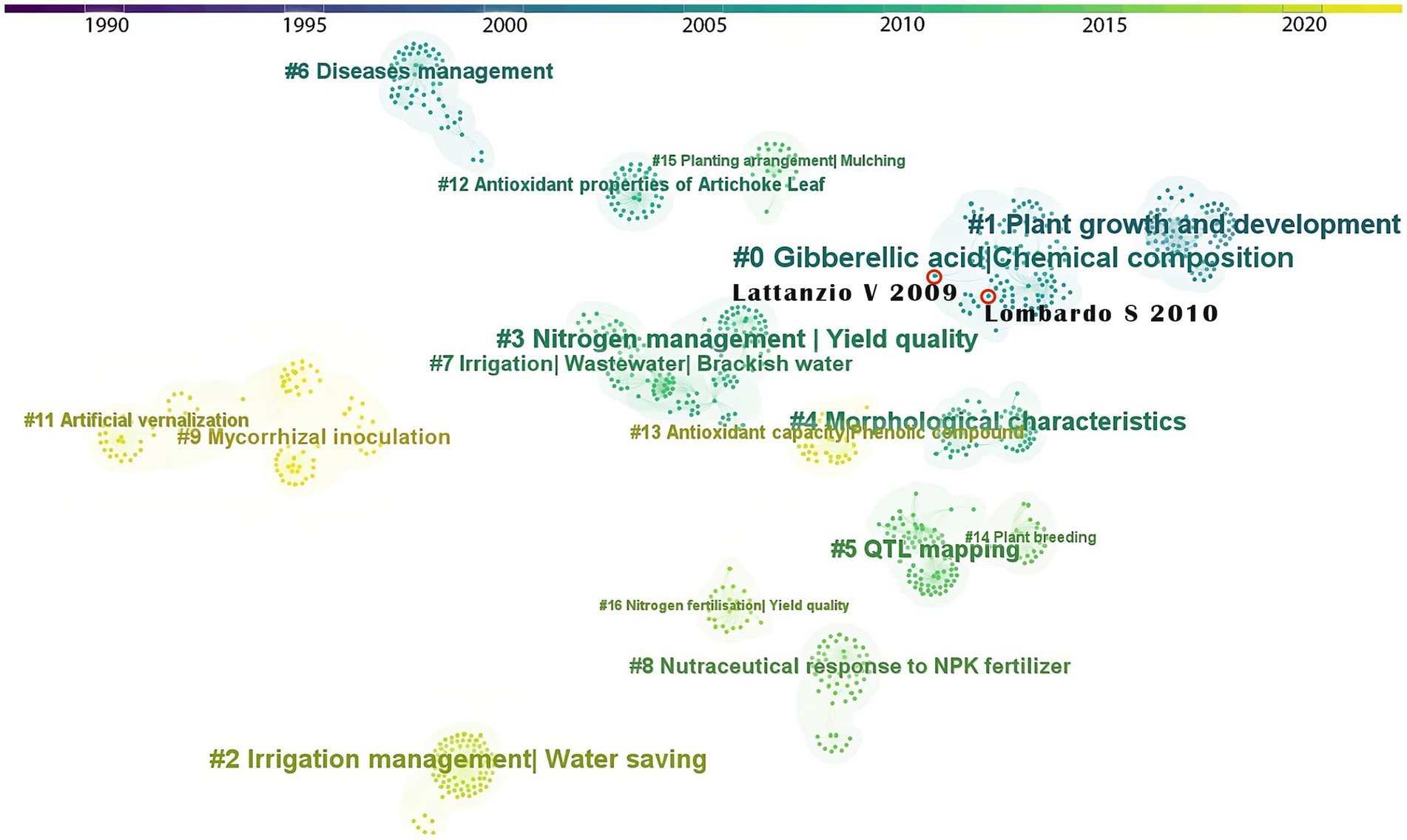
Figure 9. Co-cited reference network. Node: represents references; Link: illustrates collaborative relationships between references; Colors: display the chronological order of co-occurrence links between references. References with high centrality scores are labeled. Citation bursts are depicted as red rings. Source: CiteSpace.
4. Discussion
Bibliometric analysis was employed to examine the data of a total of 172 articles published over the course of the last 40 years (1982–2022) on the agronomic management of field globe artichoke. In this study, various bibliometric techniques such as co-citation analysis and co-occurrence analysis were utilized to examine the data in depth and deduce research trends and patterns within the field over the aforementioned period.
According to the findings of a quantitative analysis, there has been a marked decline in the number of studies published on the impact of cropping practices on globe artichoke production over the last 7 years.
During the period 1982–2022, 41.34% of all academic publications in this field belongs to Italian scholars and institutions; they have received the highest total number of citations (1478) equivalent to 55.20%. This can be seen in the most productive institutions, authors and highly-cited papers. We can consider that the level of interest on the artichoke across different regions and countries results quite dissimilar. Mainly the European countries as Italy and Spain due to the major cultivated surface with artichoke showed a closer sharing of knowledge and research. The lack of international cooperation in the field of scientific research between some artichoke-producing countries can result in a fragmented research landscape, with researchers in different areas of the world conducting studies that are not aligned with each other. This can also lead to a duplication of effort, as researchers may be conducting similar studies without being aware of each other’s work. The lack of funding may be a reason for the limited collaboration among researchers. Funding agencies may prioritize local or national research projects over international ones, leading to a lack of incentives for international collaboration. Researchers in different countries may have different research priorities, which can lead to differences in the type and scope of research being conducted. This can make it challenging to align research efforts and collaborate effectively.
When analysing the top active journals, it is crucial to take into account the credibility and reliability of the sources used (Sorenson, 2016; Ahmad and Jan, 2018). According to Table 3, Acta Horticulturae produced by International Society for Horticultural Science contains a majority of published articles even if present the lowest impact factor and quartile. While artichoke may not always be a focus of high-ranked journals, these rankings provide a broader context for understanding the prestige and impact of journals within the scientific community. on the other hand, the availability of artichoke-related research in journals of varying ranks can be indicative of the diversity of research interests and approaches in the field. Lower-ranked journals may offer unique perspectives, specialized studies, or emerging research trends that high-ranked journals might not cover. Thus, readers can benefit by exploring a spectrum of journals to gain comprehensive insights into artichoke-related research, ensuring they do not miss valuable contributions from various sources.
In our research topic, this trend it is due to the interest within International Society for Horticultural Science on the subject with a workgroup artichoke and the organization of International Symposium on Artichoke, Cardoon and their Wild Relatives every 2 years starting from the mid 90’s. Acta Horticulturae represents a peer-reviewed series, mainly for the proceedings of ISHS Symposia and the International Horticultural Congress.
The Co-word analysis (Terms and Keywords) is an effective method for comprehending the connections between various concepts within the field of globe artichoke research (Molinillo et al., 2016). After conducting a thematic analysis of the co-occurrence network of terms and keywords, we discovered that early studies in the field of cropping practices on globe artichoke production focused on topics related to the effect of bioregulator (GA3) on globe artichoke yield, a fairly standard area of study. Later on, discussions shifted to more contemporary issues, such as the impact of cropping practices on artichoke head quality. It is typical for research priorities to evolve as new questions and issues arise and as the field progresses. The change in research emphasis from the effect of bioregulators on globe artichoke yield to the impact of agronomic management on head quality could have been influenced by various factors. Some possible causes for this shift may include:
1. As the field of globe artichoke production advanced, scientists may have obtained a deeper understanding of the role of bioregulators in impacting yield and may have turned their attention to investigating other factors that affect artichoke head quality.
2. Advances in agronomic practices and techniques may have increased the understanding of factors that affect artichoke head quality, leading researchers to study the impact of these techniques in enhancing artichoke head quality.
3. The need for high-quality globe artichoke products may have risen, leading researchers to investigate the optimal practices for producing heads with desirable features.
4. The growing significance of sustainable and eco-friendly farming practices may have motivated researchers to study the impact of various cropping practices on artichoke head quality and other facets of globe artichoke production.
Co-cited analysis is a useful method for comprehending the connections between different documents. It can be employed to identify essential documents within a set and to understand the relationships between different research areas or topic areas (Nicolaisen, 2007; Ding et al., 2013). The modularity of a network, according to Chen et al. (2010), assesses the extent to which a network may be divided into various components, or modules. This metric gives a reference for the overall clarity of a specific network decomposition. A co-cited reference’s modularity factor (Q) for our research topic was 0.862, indicating that our research co-cited reference network is reasonably separated into loosely linked clusters. Numerous research fields are highly isolated from one another. The number of clusters, in this case, was determined to be 15, indicating that the research on globe artichoke cropping practices spanned diverse areas of investigation and shift in research focus over time.
The identified thematic trends over time can provide valuable insights into the evolution and progression of research interests within the field. In the earlier years, the research primarily emphasized the use of gibberellic acid and chemical composition, as well as studying plant growth and development. This suggests a focus on understanding the physiological aspects of the crop and exploring methods to enhance its growth and quality. Additionally, the investigation of water quality and disease management indicates an interest in optimizing the cultivation practices and addressing challenges associated with pests and diseases.
During the mid-range years, the research shifted towards plant breeding and QTL mapping, indicating a desire to improve crop varieties through genetic approaches. Nitrogen management and yield quality became prominent, reflecting efforts to optimize nutrient usage and enhance the overall productivity and quality of the crop.
In recent years, the research attention turned towards nutraceutical responses to NPK fertilizer, mycorrhizal inoculation, artificial vernalization, and antioxidant capacity of phenolic compounds. This suggests an increasing interest in exploring the nutritional and health-related aspects of globe artichoke, including its bioactive compounds, potential health benefits, and sustainable cultivation practices.
These research thematic trends likely emerged in response to evolving scientific interests, technological advancements, and societal demands. Factors such as emerging knowledge gaps, market demands, and environmental concerns can influence the direction of research in a particular field.
Our bibliometric analysis of “Cropping Practices of Field Globe Artichoke” provides valuable insights into the existing body of research related to artichoke cultivation practices. However, it also highlights certain research gaps that warrant further investigation. One prominent gap is the need for extensive investigations into cropping practices that can fortify globe artichoke against the ever-evolving challenges posed by climate change. While the existing literature provides valuable insights into artichoke cultivation practices, it is imperative to explore and develop strategies that specifically address the adverse effects of changing climatic conditions, including altered precipitation patterns and temperature fluctuations. This research direction is essential not only for ensuring consistent artichoke yields but also for promoting sustainable agricultural practices in the face of environmental uncertainties. Furthermore, the analysis highlights a gap concerning the temporal dimension of research outcomes. While the literature showcases strides in understanding the short-term impacts of individual cropping practices on artichoke cultivation, there is a paucity of studies examining their long-term effects. A comprehensive assessment of how these practices influence artichoke production over extended periods is crucial for establishing sustainable and resilient agricultural systems. Bridging these research gaps will contribute to the development of innovative and adaptive cropping practices for globe artichokes, aligning them with the demands of modern agriculture and a changing climate.
5. Conclusion
The aim of this paper was to recognize and assess cropping practices on globe artichoke production under field conditions. As for the current bibliometric analysis, the literature in this field of research has significantly decreased since 2016. Upon conducting an analysis of 172 previous publications in this field, we inferred that the cropping practices on globe artichoke production under field conditions covered a broad spectrum of topics in multiple fields of study, which allowed these articles to be published in various journals. However, the most prolific authors had a tendency to publish their work in the scientific society journals (Acta Horticulturae) even if the impact factor is the lowest. This may be due to the beneficial effect into spreading scientific information easily among interested researchers working on artichokes through the scientific societies. The analysed papers have also shown that cropping practices such as irrigation (wastewater and brackish water), nitrogen and diseases management and plant breeding are the most studied agronomical practices that affect artichoke yield and head quality.
Over the past decade, research on globe artichoke has evolved to address a wide range of agronomic, nutritional, and health-related issues, with a focus on improving yield, quality, and sustainability. In recent years, there has been a growing interest in the use of genetic engineering, with efforts to develop new varieties that are more resistant to biotic and abiotic stresses, have higher yields, and improved quality traits. Other agronomic practices recently investigated have their main focus on improved irrigation and fertilization practices through microbial inoculation. There is also growing interest in the nutritional and health benefits of globe artichokes, with studies focusing on identifying and characterizing the bioactive compounds responsible for these benefits, as well as the effects of different processing methods on the bioavailability and bioactivity of these compounds. These are just a few of the leading agronomic practices that have been researched in the last 10 years.
Italy has a significant impact on the field of research on globe artichoke. Globe artichoke is a native of the Mediterranean region, and Italy is a leading producer of this vegetable. It is mainly Italy Spain, Poland, Tunisia, France, the United States of America, and Canada, that collaborate together in this research field; in general, the collaboration between countries is not particularly strong. Based on the authors’ analysis, the most prolific authors collaborated in this research field within specific disciplines.
This study is subject to several limitations that merit acknowledgment. Primarily, our analysis was constrained by the inclusion of articles solely from Scopus, Web of Science, and Google Scholar databases, which inevitably led to an incomplete coverage of the entire body of literature relevant to our research topic. The omission of articles published after September 2022 is another limitation, potentially affecting the comprehensiveness and currency of our findings. Recent articles often reflect emerging trends and novel methodologies, which are pivotal for a holistic analysis. Furthermore, the exclusion of these recent articles may introduce bias into citation counts and impact measures, potentially misrepresenting the influence of specific papers.
It is vital to recognize that the scope of publications examined in this study might not precisely reflect the global research landscape concerning the impacts of agronomic practices on globe artichoke cultivation. Nonetheless, the data presented here offers valuable insights into the evolving trends both before and after the cutoff date. In light of these limitations, it is imperative to underscore the need for alternative research approaches, such as systematic reviews, to attain a more comprehensive understanding of the effects of cropping practices on globe artichoke cultivation. This will not only facilitate a broader perspective but also lay the groundwork for future research endeavors in this field.
As the globe artichoke crop continues to grow in popularity, it is likely that more research will be conducted in this area in the next future. In this perspective, such study can be a useful starting point for the scientific community in order to plan the direction for addressing new research proposals and investigations.
Author contributions
DS: Data curation, Investigation, Writing – original draft. MHS: Data curation, Investigation, Methodology, Software, Visualization, Writing – original draft, Writing – review & editing. CR: Writing – review & editing. CP: Conceptualization, Writing – review & editing. GM: Conceptualization, Supervision, Writing – review & editing.
Funding
The author(s) declare financial support was received for the research, authorship, and/or publication of this article. This work was supported by the Apulia Region project: “Innovazioni di processo e di marketing per la valorizzazione del carciofo pugliese in un’ottica sostenibile—ICARUS” (P.S.R. Puglia 2014/2020 -Misura 16.2).
Conflict of interest
The authors declare that the research was conducted in the absence of any commercial or financial relationships that could be construed as a potential conflict of interest.
The author(s) declared that they were an editorial board member of Frontiers, at the time of submission. This had no impact on the peer review process and the final decision.
Publisher’s note
All claims expressed in this article are solely those of the authors and do not necessarily represent those of their affiliated organizations, or those of the publisher, the editors and the reviewers. Any product that may be evaluated in this article, or claim that may be made by its manufacturer, is not guaranteed or endorsed by the publisher.
References
Ahmad, M., and Jan, M. A. (2018). Evaluating research: diversity and credibility of information sources. Dialogue (Pakistan) 13, 353–368.
Alzubaidi, N. A. K., and Al Diwan, M. A. (2013). The effect of taurine on reproductive efficiency in male rats fed high cholesterol diet. Basra J. Vet. Res. 12, 30–40. doi: 10.33762/bvetr.2013.76186
Anwar, R., Mahmoud, M., and Hussien, N. (2017). Effect of irrigation and potassium fertilizer on vegetative growth, yield and quality of globe artichoke plants under Sandy soil conditions. J. Plant Prod. 8, 1267–1276. doi: 10.21608/jpp.2017.41308
Aria, M., and Cuccurullo, C. (2017). Bibliometrix: an R-tool for comprehensive science mapping analysis. J. Informetr. 11, 959–975. doi: 10.1016/j.joi.2017.08.007
Bekheet, S., and Sota, V. (2019). Biodiversity and medicinal uses of globe artichoke (Cynara scolymus L.) plant. J. Biodiv. Conserv. Bioresour. Manag. 5, 39–54. doi: 10.3329/jbcbm.v5i1.42184
Ben Salem, M., Affes, H., Athmouni, K., Ksouda, K., Dhouibi, R., Sahnoun, Z., et al. (2017). Chemicals compositions, antioxidant and anti-inflammatory activity of Cynara scolymus leaves extracts, and analysis of major bioactive polyphenols by HPLC. Evid. Based Complement. Altern. Med. 2017:e4951937. doi: 10.1155/2017/4951937
Bianco, V. V., and Calabrese, N. (2009). “Morphologia e Fisiologia” in Il carciofo e il cardo. eds. R. Angelini, N. Calabrese, and I. Ponti (Milano, Italy: Bayer CropScience S.r.l.), 11–17.
Bundy, R., Walker, A. F., Middleton, R. W., Wallis, C., and Simpson, H. C. R. (2008). Artichoke leaf extract (Cynara scolymus) reduces plasma cholesterol in otherwise healthy hypercholesterolemic adults: a randomized, double-blind placebo-controlled trial. Phytomedicine 15, 668–675. doi: 10.1016/j.phymed.2008.03.001
Cavini, S., Guzzetti, L., Givoia, F., Regonesi, M. E., Di Gennaro, P., Magoni, C., et al. (2020). Artichoke (Cynara cardunculus var. scolymus L.) by-products as a source of inulin: how to valorise an agricultural supply chain extracting an added-value compound. Nat. Prod. Res. 36, 2140–2144. doi: 10.1080/14786419.2020.1841188
Ceccarelli, N., Curadi, M., Martelloni, L., Sbrana, C., Picciarelli, P., and Giovannetti, M. (2010). Mycorrhizal colonization impacts on phenolic content and antioxidant properties of artichoke leaves and flower heads two years after field transplant. Plant Soil 335, 311–323. doi: 10.1007/s11104-010-0417-z
Chen, C. (2006). CiteSpace II: detecting and visualizing emerging trends and transient patterns in scientific literature. JASIST 57, 359–377. doi: 10.1002/asi.20317
Chen, C., Ibekwe-SanJuan, F., and Hou, J. (2010). The structure and dynamics of co-citation clusters: a multiple-perspective co-citation analysis. J. Am. Soc. Inf. Sci. 61, 1386–1409. doi: 10.1002/asi.21309
Ding, Y., Liu, X., Guo, C., and Cronin, B. (2013). The distribution of references across texts: some implications for citation analysis. J. Informetr. 7, 583–592. doi: 10.1016/j.joi.2013.03.003
Food and Agricultural Organization (2021). FAOSTAT statistical database. [Rome]: FAO. Available at: http://www.fao.org/faostat/en/ [Accessed December 20, 2022].
Foti, S., Mauromicale, G., Raccuia, S. A., Fallico, B., Fanella, F., and Maccarone, E. (1999). Possible alternative utilization of Cynara spp. Ind. Crop. Prod. 10, 219–228. doi: 10.1016/s0926-6690(99)00026-6
Fracchiolla, M., Lasorella, C., Cazzato, E., and Renna, M. (2022). Living mulch with subterranean clover (Trifolium subterraneum L.) is effective for a sustainable weed management in globe artichoke as annual cropping in Puglia (southern Italy). Horticulturae 8:825. doi: 10.3390/horticulturae8090825
Gatta, G., Libutti, A., Beneduce, L., Gagliardi, A., Disciglio, G., Lonigro, A., et al. (2016). Reuse of treated municipal wastewater for globe artichoke irrigation: assessment of effects on morpho-quantitative parameters and microbial safety of yield. Sci. Hortic. 213, 55–65. doi: 10.1016/j.scienta.2016.10.011
Ierna, A., and Mauromicale, G. (2010). Cynara cardunculus L. genotypes as a crop for energy purposes in a Mediterranean environment. Biomass Bioenergy 34, 754–760. doi: 10.1016/j.biombioe.2010.01.018
Lattanzio, V., Kroon, P. A., Linsalata, V., and Cardinali, A. (2009). Globe artichoke: a functional food and source of nutraceutical ingredients. JFF 1, 131–144. doi: 10.1016/j.jff.2009.01.002
Leskovar, D., and Othman, Y. (2016). Low nitrogen fertigation promotes root development and transplant quality in globe artichoke. HortScience 51, 567–572. doi: 10.21273/hortsci.51.5.567
Leskovar, D. I., Xu, C., and Agehara, S. (2013). Planting configuration and plasticulture effects on growth, physiology, and yield of globe artichoke. HortScience 48, 1496–1501. doi: 10.21273/hortsci.48.12.1496
Lombardo, S., Pandino, G., Mauromicale, G., Knödler, M., Carle, R., and Schieber, A. (2010). Influence of genotype, harvest time and plant part on polyphenolic composition of globe artichoke [Cynara cardunculus L. var. scolymus (L.) Fiori]. Food Chem. 119, 1175–1181. doi: 10.1016/j.foodchem.2009.08.033
López-Anido, F., and Martin, E. (2021). Globe artichoke (Cynara cardunculus var. scolymus L.) breeding. Advances in plant breeding strategies: vegetable crops: Volume 10. Leaves, Flowerheads, Green Pods, Mushrooms and Truffles, 303–330.
Mauro, R., Portis, E., Acquadro, A., Lombardo, S., Mauromicale, G., and Lanteri, S. (2008). Genetic diversity of globe artichoke landraces from Sicilian small-holdings: implications for evolution and domestication of the species. Conserv. Genet. 10, 431–440. doi: 10.1007/s10592-008-9621-2
Mauromicale, G., and Ierna, A. (1995). Effects of gibberellic acid and sowing date on harvest time and yields of seed-grown globe artichoke (Cynara scolymus L). Agronomie 15, 527–538. doi: 10.1051/agro:19950902
Mehmetçik, G., Özdemirler, G., Koçak-Toker, N., Çevikbaş, U., and Uysal, M. (2008). Effect of pretreatment with artichoke extract on carbon tetrachloride-induced liver injury and oxidative stress. Exp. Toxicol. Pathol. 60, 475–480. doi: 10.1016/j.etp.2008.04.014
Molinillo, S., Ekinci, Y., Whyatt, G., Occhiocupo, N., and Stone, M. (2016). “Private label management: insights and research directions” in Handbook of Research on strategic retailing of private label products in a recovering economy. eds. M. Gómez-Suárez and M. P. Martínez-Ruiz (Pennsylvanie, USA: IGI Global), 1–27.
Nicolaisen, J. (2007). Citation analysis. Annu. Rev. Inf. Sci. Technol. 41, 609–641. doi: 10.1002/aris.2007.1440410120
Norris, S. (2019). Bibliometrics and Research evaluation: uses and abuses. JLSC 7:eP2286. doi: 10.7710/2162-3309.2286
Pandino, G., Lombardo, S., Lo Monaco, A., Ruta, C., and Mauromicale, G. (2022). Mycorrhizal inoculation improves plant growth and yield of micropropagated early globe artichoke under field conditions. Agriculture 12:114. doi: 10.3390/agriculture12010114
Petropoulos, S. A., Sami, R., Benajiba, N., Zewail, R. M. Y., and Mohamed, M. H. M. (2022). The response of globe artichoke plants to potassium fertilization combined with the foliar spraying of seaweed extract. Agronomy 12:490. doi: 10.3390/agronomy12020490
Research, Z. M. (2016). Global artichoke extract market: size, trends, industry share and forecast, 2016–2024. Available at: https://www.zionmarketresearch.com/report/artichoke-extract-market [Accessed May10, 2023].
Rezazadeh, K., Aliashrafi, S., Asghari-Jafarabadi, M., and Ebrahimi-Mameghani, M. (2018). Antioxidant response to artichoke leaf extract supplementation in metabolic syndrome: a double-blind placebo-controlled randomized clinical trial. Clin. Nutr. 37, 790–796. doi: 10.1016/j.clnu.2017.03.017
Rondanelli, M., Opizzi, A., Faliva, M., Sala, P., Perna, S., Riva, A., et al. (2013). Metabolic Management in Overweight Subjects with naive impaired fasting glycaemia by means of a highly standardized extract from Cynara scolymus: a double-blind, placebo-controlled, randomized clinical trial. Phytother. Res. 28, 33–41. doi: 10.1002/ptr.4950
Rons, N., and De Bruyn, A. (2013). Quality related publication categories in social sciences and humanities, based on a university's peer review assessments. arXiv 1307:6773. doi: 10.48550/arXiv.1307.6773
Roudsari, N. M., Lashgari, N.-A., Momtaz, S., Farzaei, M. H., Marques, A. M., and Abdolghaffari, A. H. (2019). Natural polyphenols for the prevention of irritable bowel syndrome: molecular mechanisms and targets; a comprehensive review. DARU J. Pharm. Sci. 27, 755–780. doi: 10.1007/s40199-019-00284-1
Rouphael, Y., Bernardi, J., Cardarelli, M., Bernardo, L., Kane, D., Colla, G., et al. (2016). Phenolic compounds and Sesquiterpene lactones profile in leaves of nineteen artichoke cultivars. J. Agric. Food Chem. 64, 8540–8548. doi: 10.1021/acs.jafc.6b03856
Rouphael, Y., Colla, G., Graziani, G., Ritieni, A., Cardarelli, M., and De Pascale, S. (2017). Phenolic composition, antioxidant activity and mineral profile in two seed-propagated artichoke cultivars as affected by microbial inoculants and planting time. J. Agric. Food Chem. 234, 10–19. doi: 10.1016/j.foodchem.2017.04.175
Sonnante, G., Pignone, D., and Hammer, K. (2007). The domestication of artichoke and cardoon: from Roman times to the genomic age. Ann. Bot. 100, 1095–1100. doi: 10.1093/aob/mcm127
Sorenson, M. E. (2016). Beyond the Google search bar: evaluating source credibility in contemporary research. Commun. Teach. 30, 82–86. doi: 10.1080/17404622.2016.1139150
Spanò, R., Fortunato, S., Linsalata, V., D’Antuono, I., Cardinali, A., de Pinto, M. C., et al. (2023). Comparative analysis of bioactive compounds in two globe artichoke ecotypes sanitized and non-sanitized from viral infections. Plan. Theory 12:1600. doi: 10.3390/plants12081600
Tartoura, E. A., Seif El-Deen, U. M., and El-Adawy, A. Y. (2021). Effect of irrigation intervals and foliar applications with some Nano-fertilizers on growth and productivity of globe artichoke plant: A-vegetative growth and chemical content in leaves. J. Plant Prod. 12, 209–216. doi: 10.21608/jpp.2021.154341
Tjamos, E. C., and Paplomatas, E. J. (1988). Long-term effect of soil solarization in controlling verticillium wilt of globe artichokes in Greece. Plant Pathol. 37, 507–515. doi: 10.1111/j.1365-3059.1988.tb02108.x
Todeschini, R., and Baccini, A. (2016). Handbook of bibliometric indicators: Quantitative tools for studying and evaluating research. Weinheim, Germany: Wiley-VCH. 55, 12144.
Keywords: Cynara cardunculus L. var. scolymus (L.) Fiori, keywords co-occurrence analysis, agronomic practices, co-citation analysis, bibliometric analysis
Citation: Stea D, Sellami MH, Ruta C, Pulvento C and De Mastro G (2023) Cropping practices of globe artichoke: a bibliometric study. Front. Sustain. Food Syst. 7:1274714. doi: 10.3389/fsufs.2023.1274714
Edited by:
Matteo Balderacchi, Independent researcher, Piacenza, ItalyReviewed by:
Valbona Sota, University of Tirana, AlbaniaAurelio Scavo, University of Catania, Italy
Copyright © 2023 Stea, Sellami, Ruta, Pulvento and De Mastro. This is an open-access article distributed under the terms of the Creative Commons Attribution License (CC BY). The use, distribution or reproduction in other forums is permitted, provided the original author(s) and the copyright owner(s) are credited and that the original publication in this journal is cited, in accordance with accepted academic practice. No use, distribution or reproduction is permitted which does not comply with these terms.
*Correspondence: Mohamed Houssemeddine Sellami, bW9oYW1lZC5zZWxsYW1pQGlzYWZvbS5jbnIuaXQ=; Cataldo Pulvento, Y2F0YWxkby5wdWx2ZW50b0B1bmliYS5pdA==
 Donato Stea1
Donato Stea1 Mohamed Houssemeddine Sellami
Mohamed Houssemeddine Sellami Cataldo Pulvento
Cataldo Pulvento Giuseppe De Mastro
Giuseppe De Mastro
